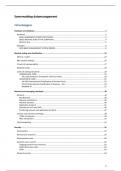Summary
Summary Clinical Exercise Physiology tm week 10
- Course
- Institution
This summary describes the main lines of the Clinical Exercise Physiology course. The summary is divided into the different weeks that the subject has. For example, the following components are covered: respiration, circulation, the influence of exercise on the body, the building of muscles with th...
[Show more]












